
Women’s History Month: 24 video lessons about famous women in history
March is Women’s History Month. It’s the perfect time to teach students about famous women in history and support women’s rights. These video lessons and activities can be used in your classroom during March, but it’s important to teach about notable women figures year-round. You can use these resources at any time of the school year to inspire students and teach them about women’s rights and history. Keep reading to explore Flocabulary’s Women’s History Month activities and videos for students!
The power of Flocabulary for teaching women’s history
Flocabulary accelerates student learning by building academic vocabulary and comprehension through rigorous and authentically engaging instructional experiences. These K-12 standard-aligned video-based lessons and activities leverage the power of hip-hop, storytelling, and emotional connections to cultivate literacy across the curriculum.
Here’s an example of the type of engaging videos you can find on Flocabulary:
Each Flocabulary video lesson sequence includes activities that follow Bloom’s Taxonomy. Here are all of the activities you can find in each of these lessons:
- Video: Flocabulary’s videos cleverly intertwine hip-hop, storytelling, and vocabulary instruction to help teach about women’s history in a captivating way. Through these engaging narratives, students not only learn about Women’s History but also connect emotionally with the struggles and triumphs of women throughout time.
- Vocab Cards: The Vocab Cards prompt students to write and draw key words related to Women’s History, such as “suffrage,” “feminism,” or “trailblazer.” Teachers can incorporate social studies vocabulary to ensure students grasp the definitions while understanding the historical context and significance behind these words.
- Vocab Game: Test vocabulary knowledge by having students drag the word to match the definition and images and fill in the blanks. Each correct answer will add an instrument to create a fun beat at the end for students to enjoy. By gamifying vocabulary acquisition, students are motivated to actively engage with women’s history topics.
- Break it Down: Challenge students to cite evidence from the video to support responses to key questions from the lesson to build their comprehension and literacy skills.
- Read & Respond: Have students read the women’s history passages from the lesson and respond to text-dependent questions. This will enhance their literacy and comprehension skills while deepening their understanding of the topic.
- Quiz: Assess comprehension of key historical content and vocabulary from the lesson.
- Lyric Lab: Students can create their own rhymes using our vocab words, rhyme generator, and beats, to demonstrate mastery. Teachers can encourage students to explore themes related to women’s empowerment, resilience, and activism in their lyrics, drawing inspiration from historical figures and events.
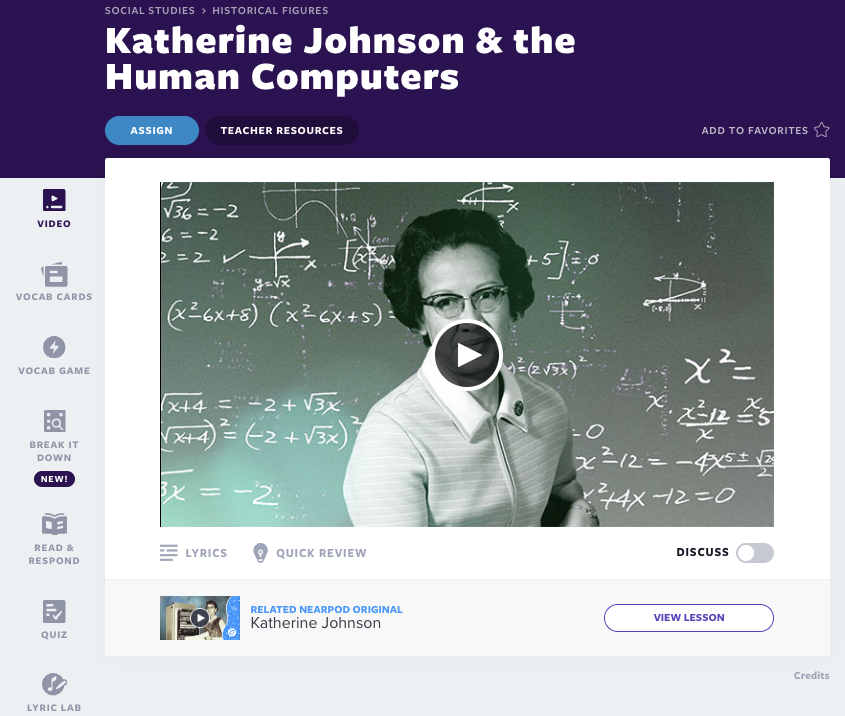
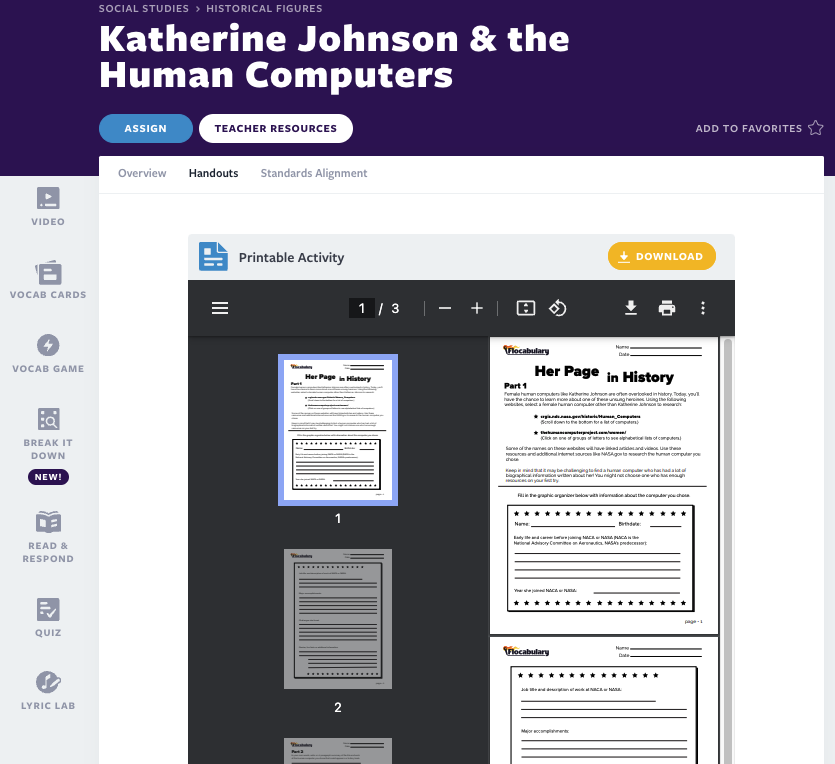
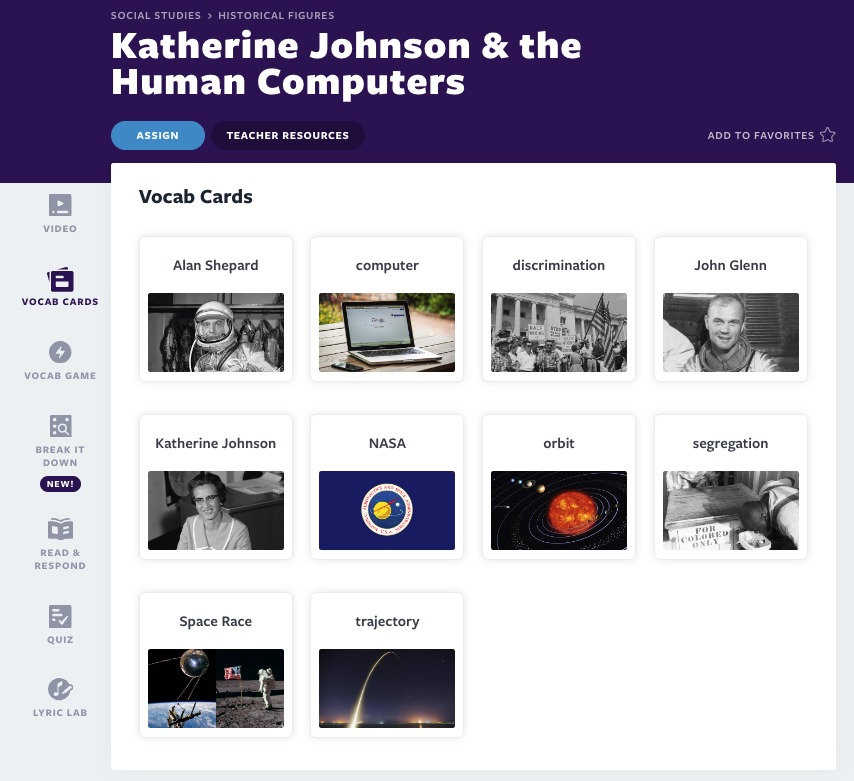
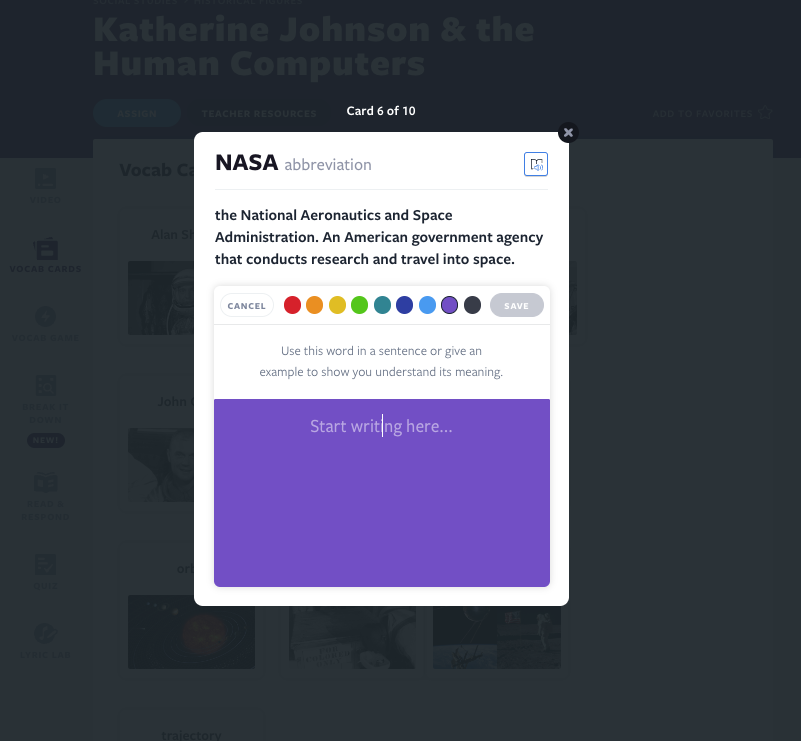
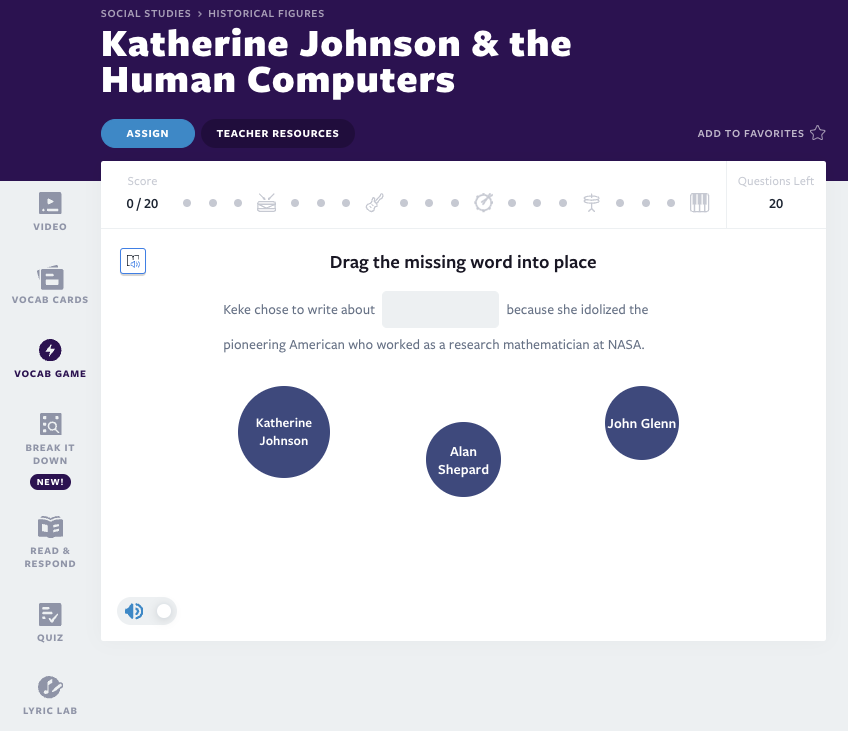
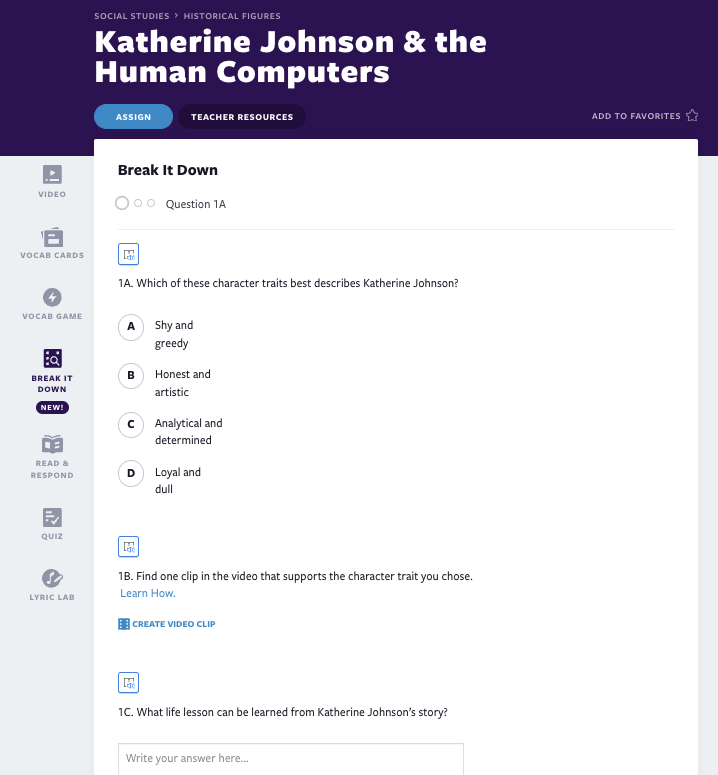
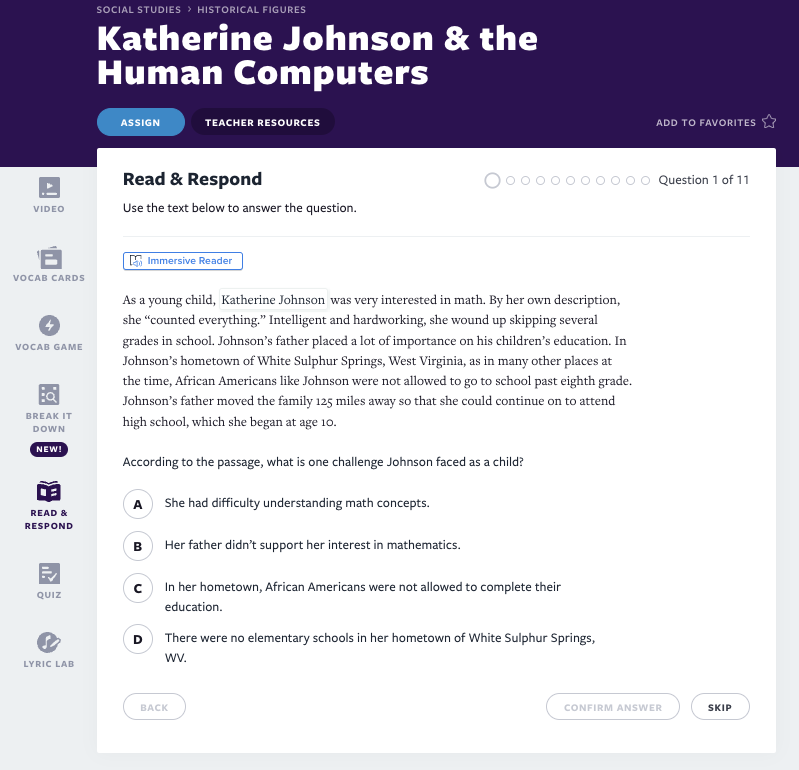
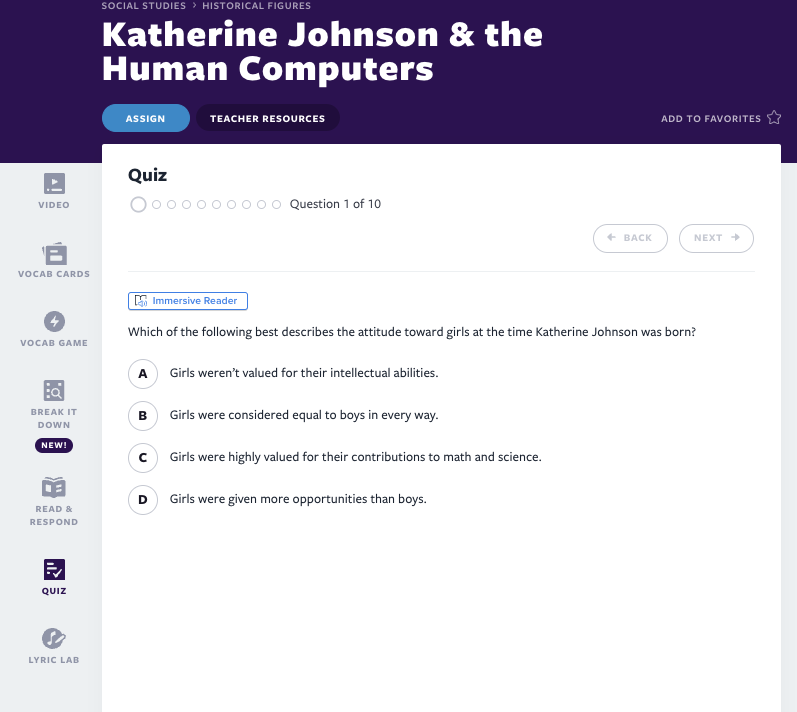
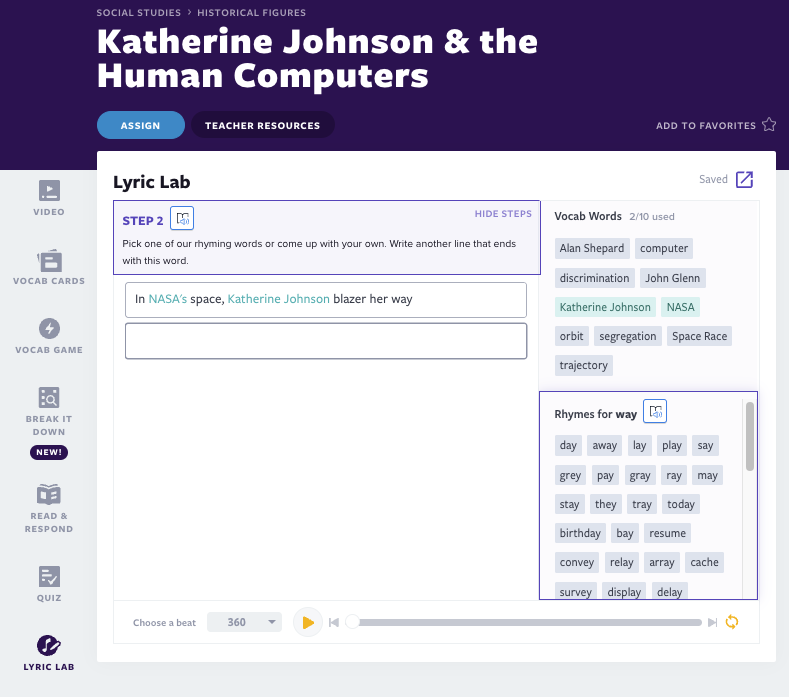
New to Flocabulary? Teachers can sign up for a trial to access our lesson videos and assessment activities. Administrators can get in touch with us to learn more about unlocking the full power of Flocabulary through Flocabulary Plus.
Women’s History Month: 24 Video lessons to teach about famous women in history
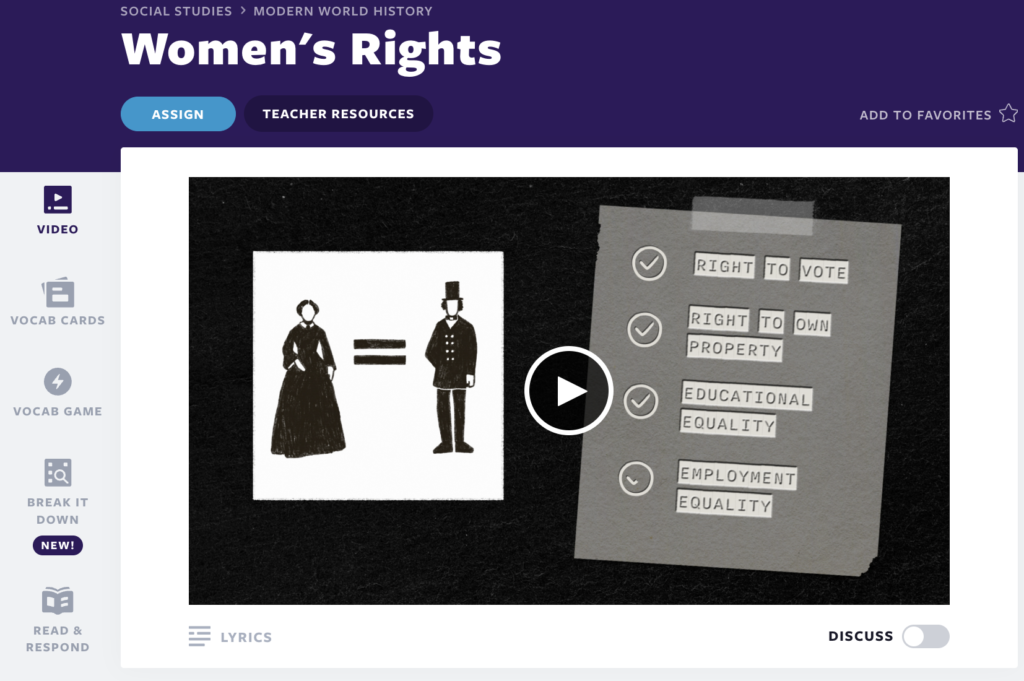
1. Women’s Rights
In this lesson, students learn about the women’s rights movement. They will follow the significant events as well as the influential activists who contributed to the fight for women’s rights. Kick off your instruction with this video in your Women’s History Month lesson plans.
2. Frida Kahlo
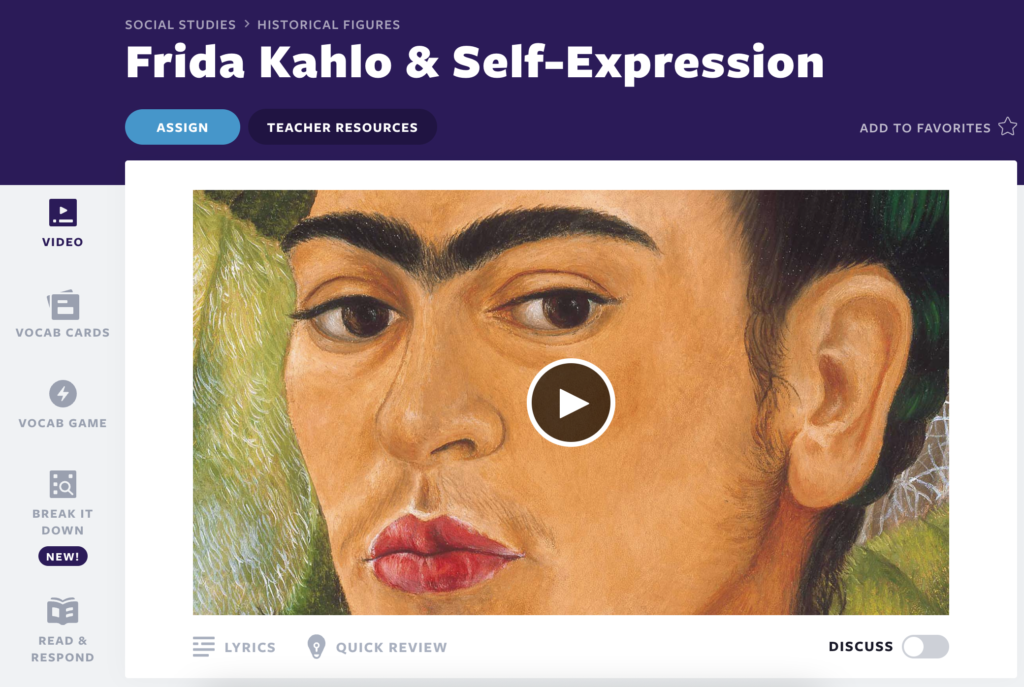
The Mexican artist Frida Kahlo is well-known for self-portraits in which she examined themes of cultural identity and femininity with an innovative style rich with symbolism. In this lesson, students will hear about Kahlo in Spanish and English (with subtitles for both). They will learn about Kahlo’s childhood, her marriage to the muralist Diego Rivera, the adversity she overcame, and how she learned to embrace her unique spirit and vision.
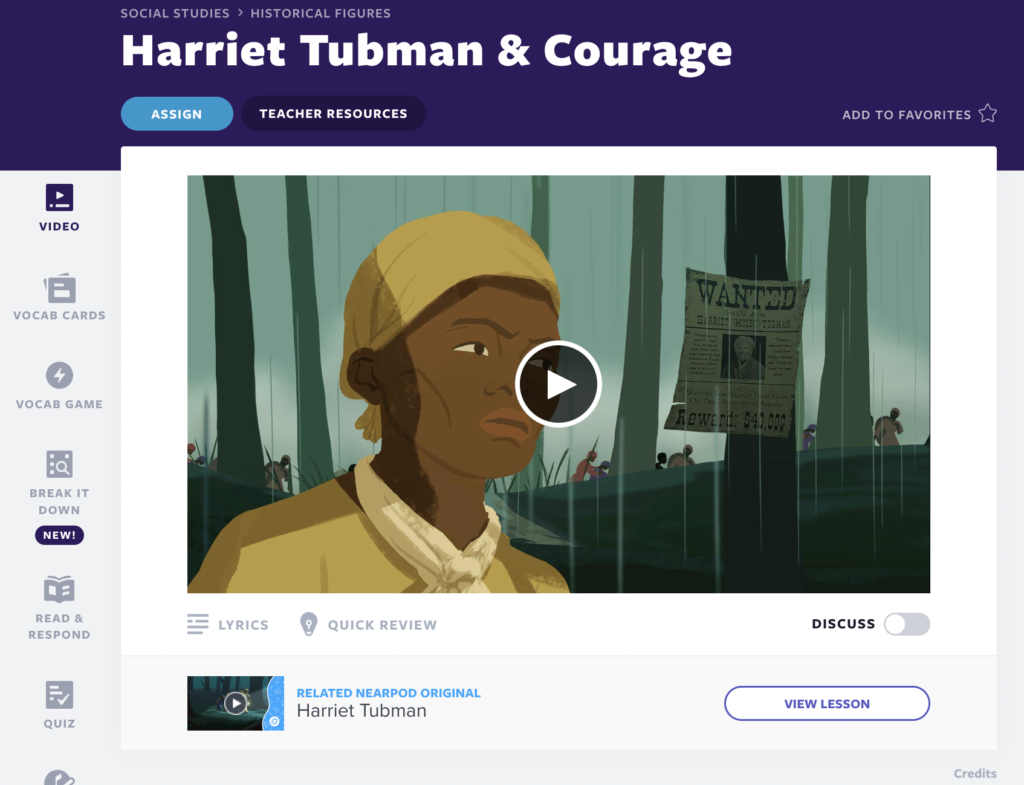
3. Harriet Tubman
In this Flocabulary video, students learn about the biography of American heroine Harriet Tubman and Tubman’s contributions toward abolishing slavery. They’ll learn how Tubman escaped to freedom in Philadelphia, only to return to the South over and over to help others find their way North through the Underground Railroad. Teach Women’s History Month activities for elementary and middle school with this video.
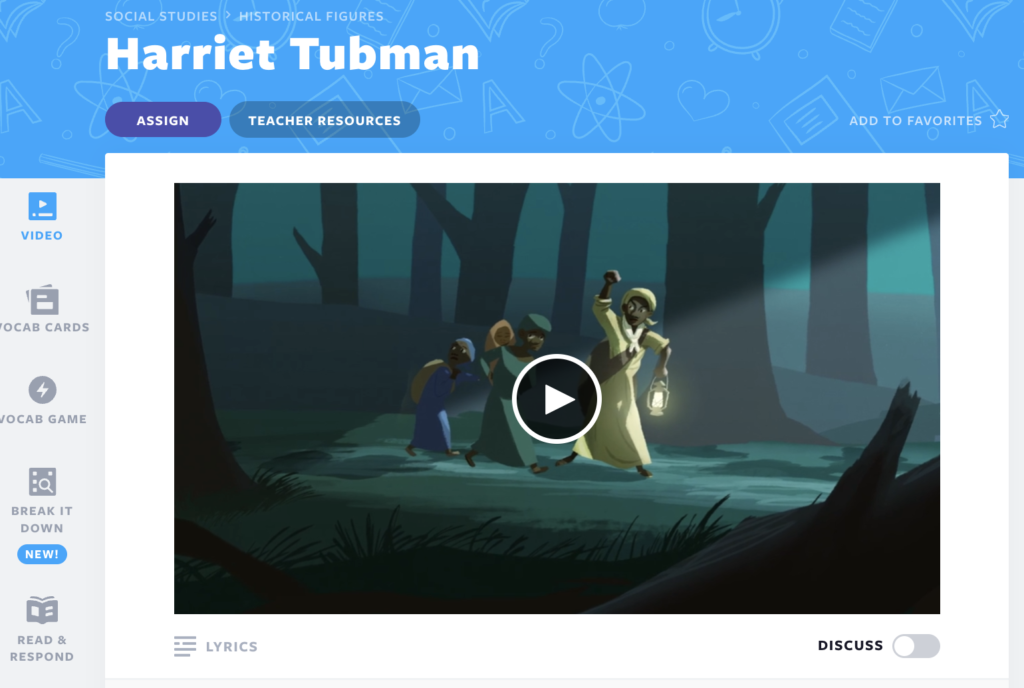
4. Harriet Tubman: Nearpod Original
Additionally, in this one-minute Nearpod Original video, students learn about this heroine who played a key part in the abolition of slavery. A host explains Tubman’s role on the Underground Railroad, and students consider her character traits.
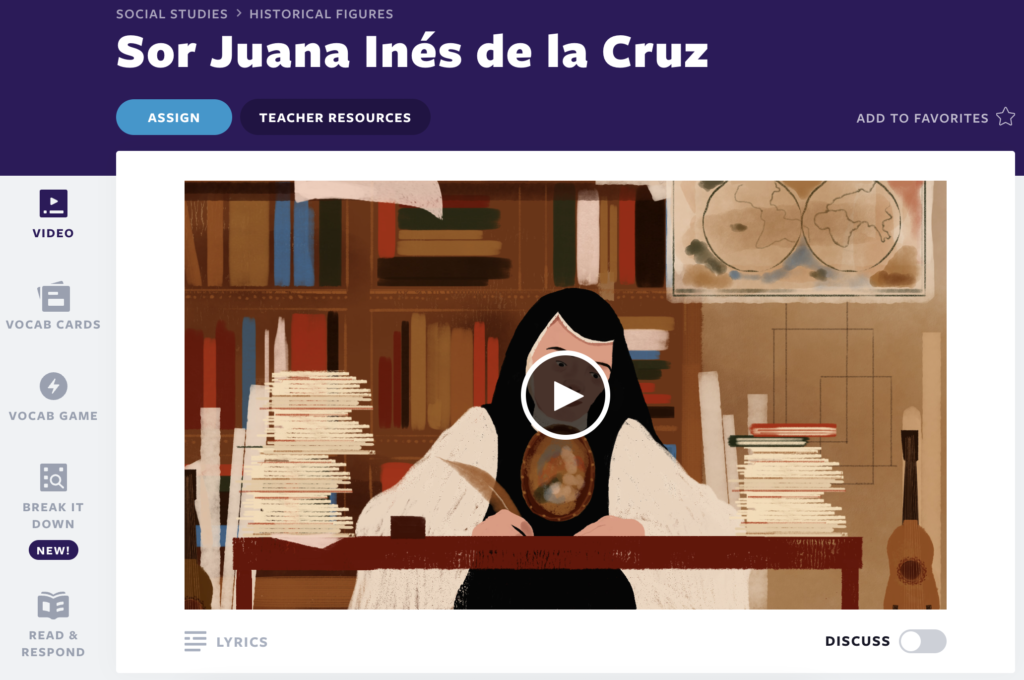
5. Sor Juana Inés de la Cruz
The Mexican phoenix, Sor Juana, was a genius. In this lesson, students learn about Sor Juana Inés de la Cruz, a 17th-century scholar, nun, and champion for women’s education. They learn how her life was filled with controversy and consider how her legacy lives on today.
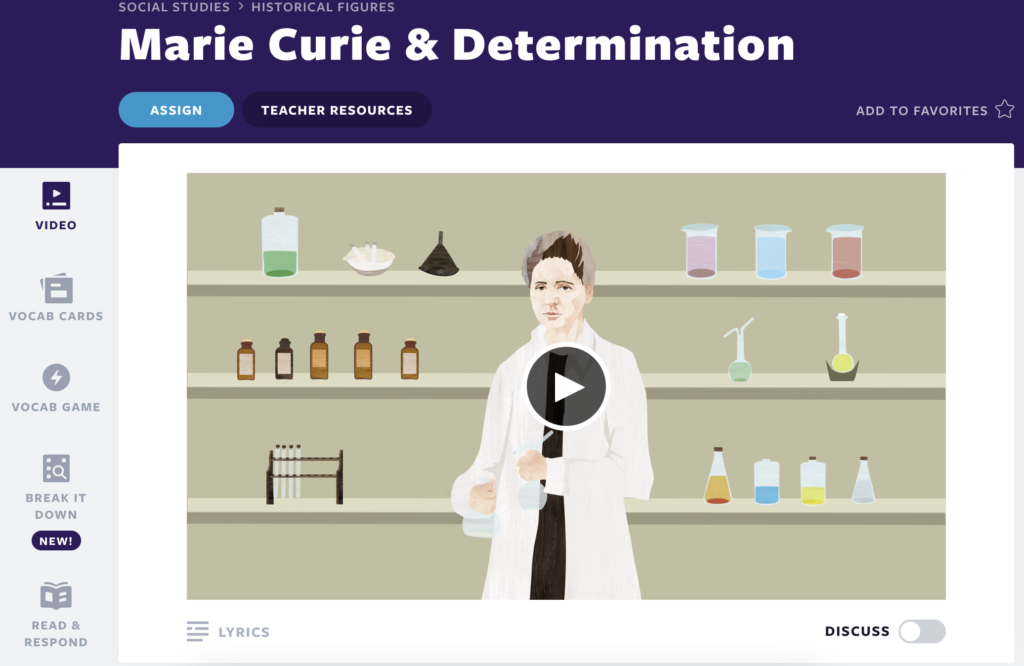
6. Marie Curie
Polish-French scientist Marie Curie is known for her discoveries in the fields of chemistry and physics. In this lesson, students will learn about Curie’s fearless determination to get an education and her path to becoming a pioneer in science, even when she had to go against societal norms to do so. They will also learn about her patriotic efforts for France during World War I.
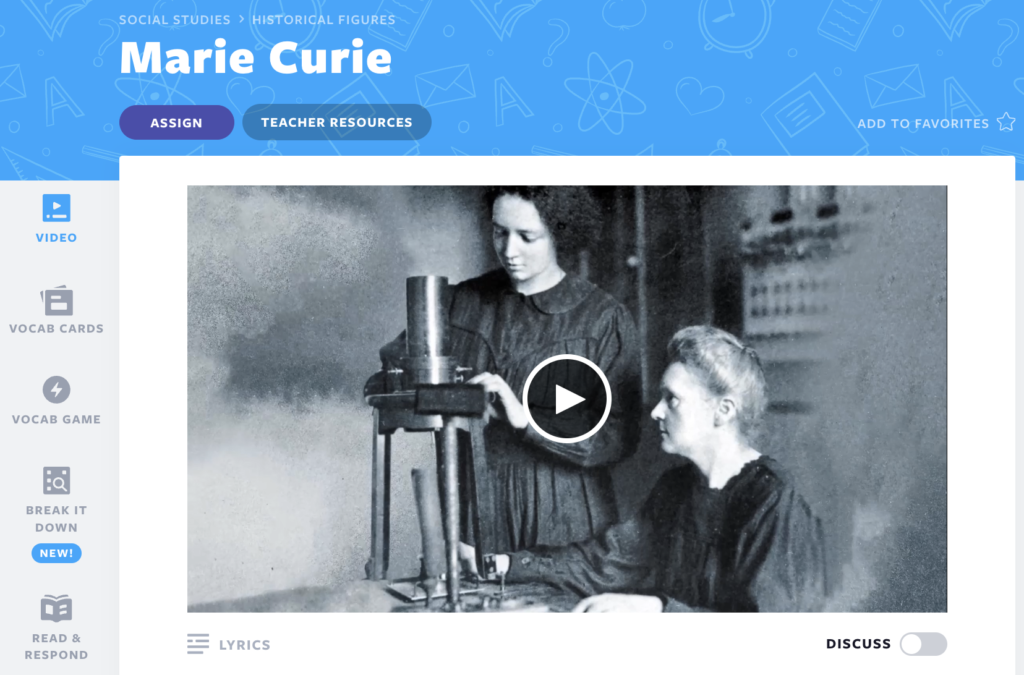
7. Marie Curie: Nearpod Original
In this one-minute Nearpod video, students learn about the Polish physicist and chemist. A host explains how Marie Curie’s work on radioactivity earned her two Nobel Prizes. Include this video in your Women’s History Month lessons as a hook.
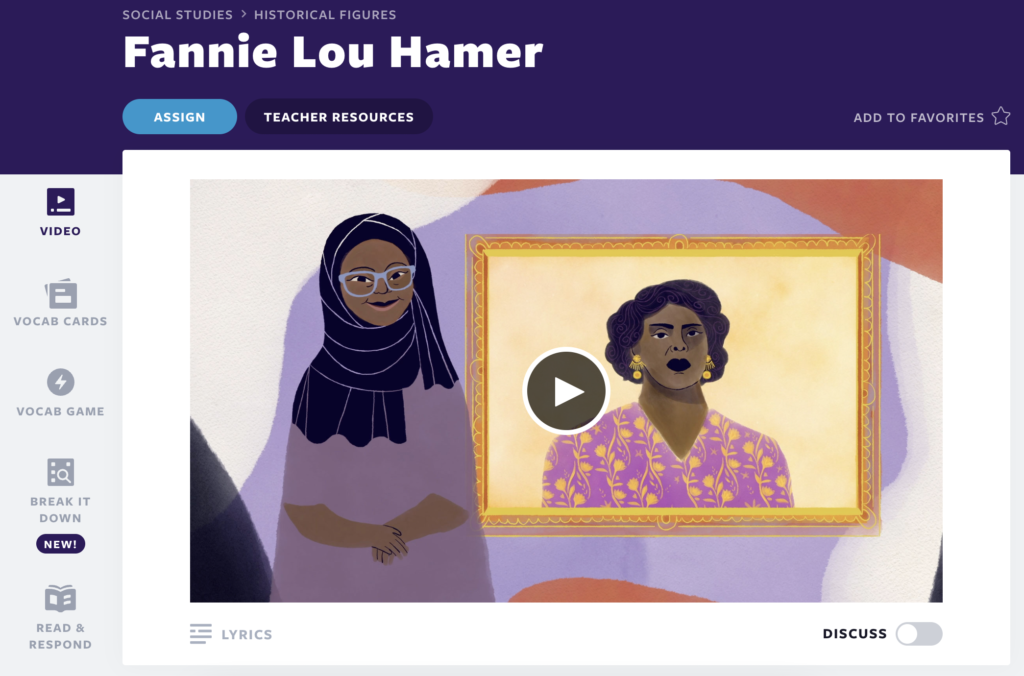
8. Fannie Lou Hamer
“Nobody’s free until everybody’s free.” In this lesson, students learn about Fannie Lou Hamer, a leading voice of the civil rights movement. They consider her rise to activism through the Student Nonviolent Coordinating Committee (SNCC) and her pivotal testimony at the 1964 Democratic National Convention.
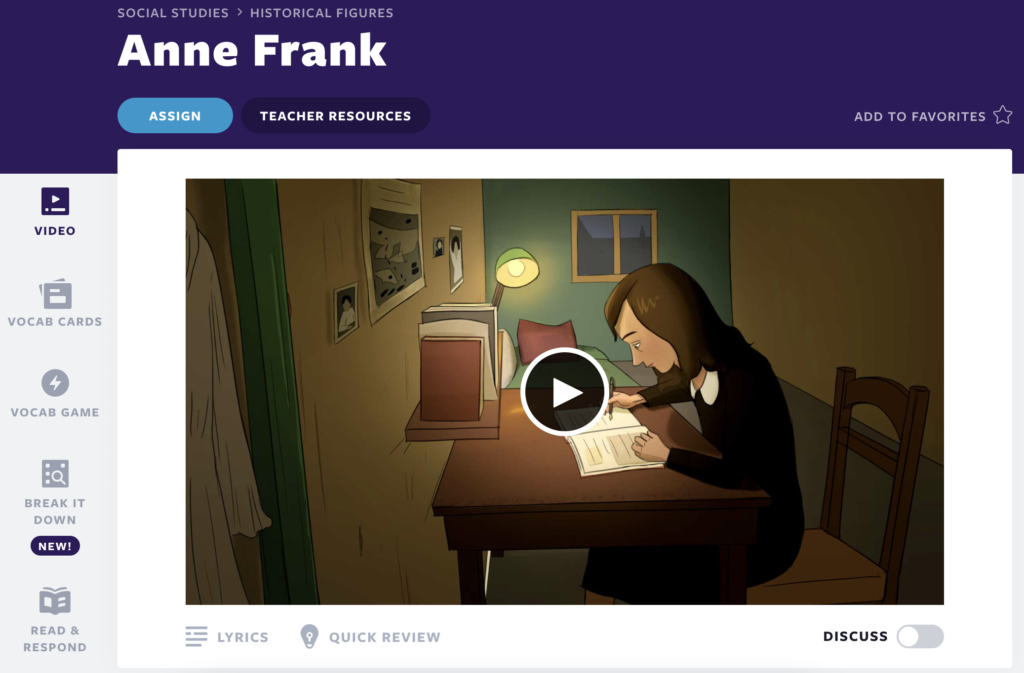
9. Anne Frank
In this video, students will learn about Anne Frank’s short life and the significance of the diary she kept while hiding from the Nazi government during the Holocaust. The unit describes Frank’s incredible bravery, determination, and hopes shown through excerpts from her diary.
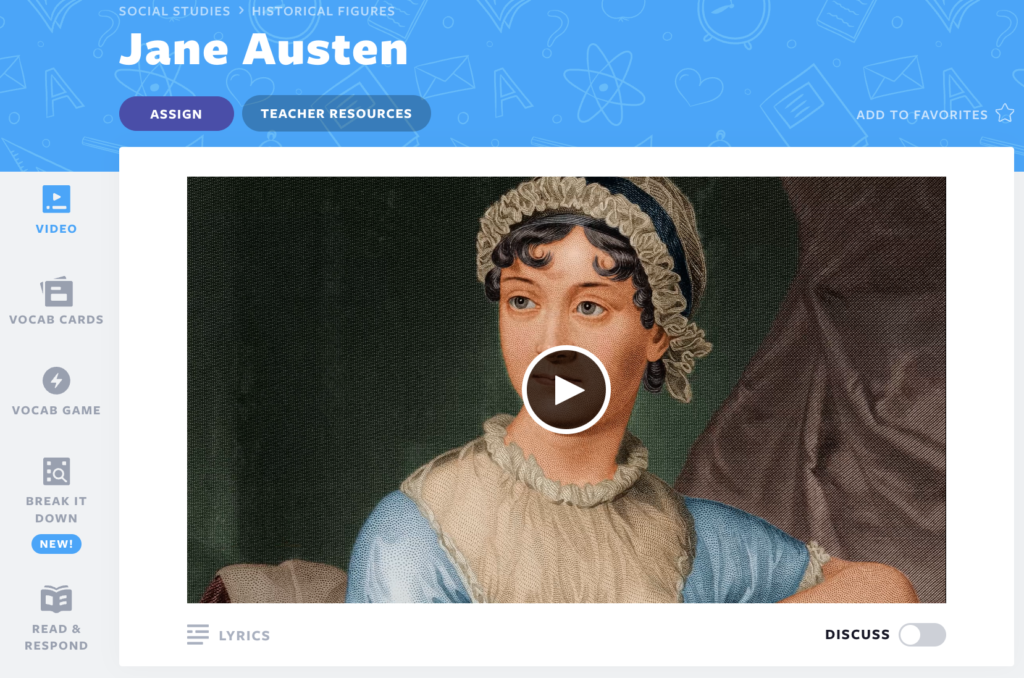
10. Jane Austen: Nearpod Original
In this one-minute Nearpod Original video, students learn about Jane Austen. A host introduces the concept of a novel of manners, and students consider how Austen has influenced modern literature.
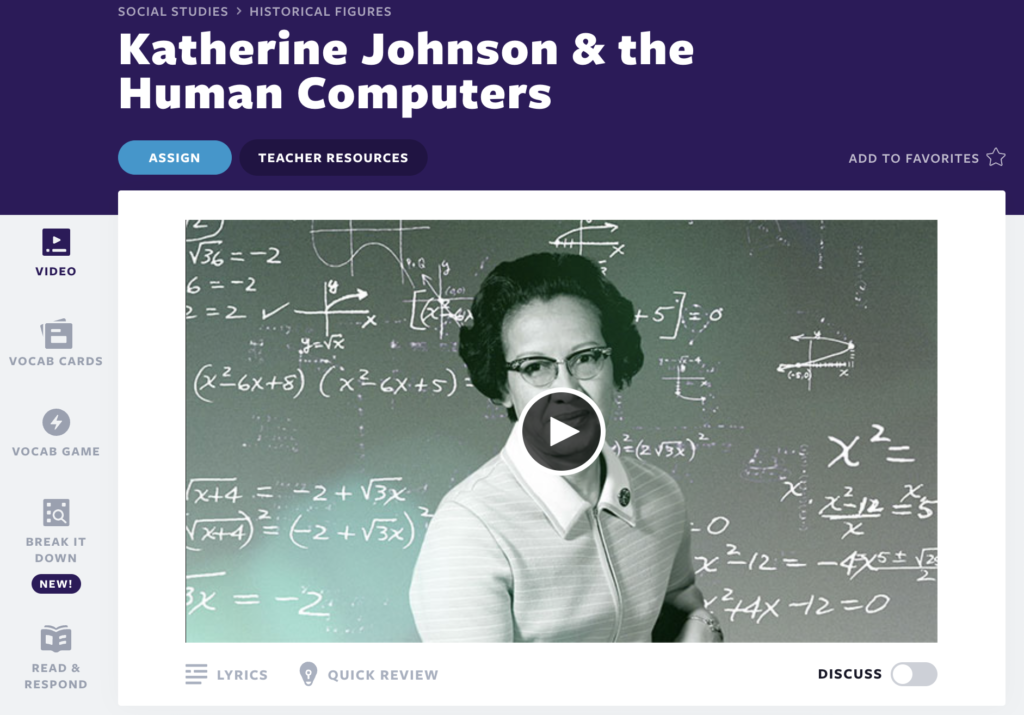
11. Katherine Johnson
You’ve likely heard of John Glenn, Alan Shepard, and Neil Armstrong—but do you know Katherine Johnson? This lesson tells the biography of Johnson, a female African-American research mathematician who made huge contributions at NASA during the Space Race but remains largely unsung in US history.
Students learn about major events and achievements in Johnson’s life and the work of human computers, women who completed crucial, precise math calculations for NASA’s engineers. Students will place Johnson’s story in the context of racial segregation and gender discrimination and learn how she paved the way for future generations of students in STEM. This video provides a rich angle for a lesson on the Civil Rights Movement, the Space Race, the Women’s Rights Movement, or the history of computing.
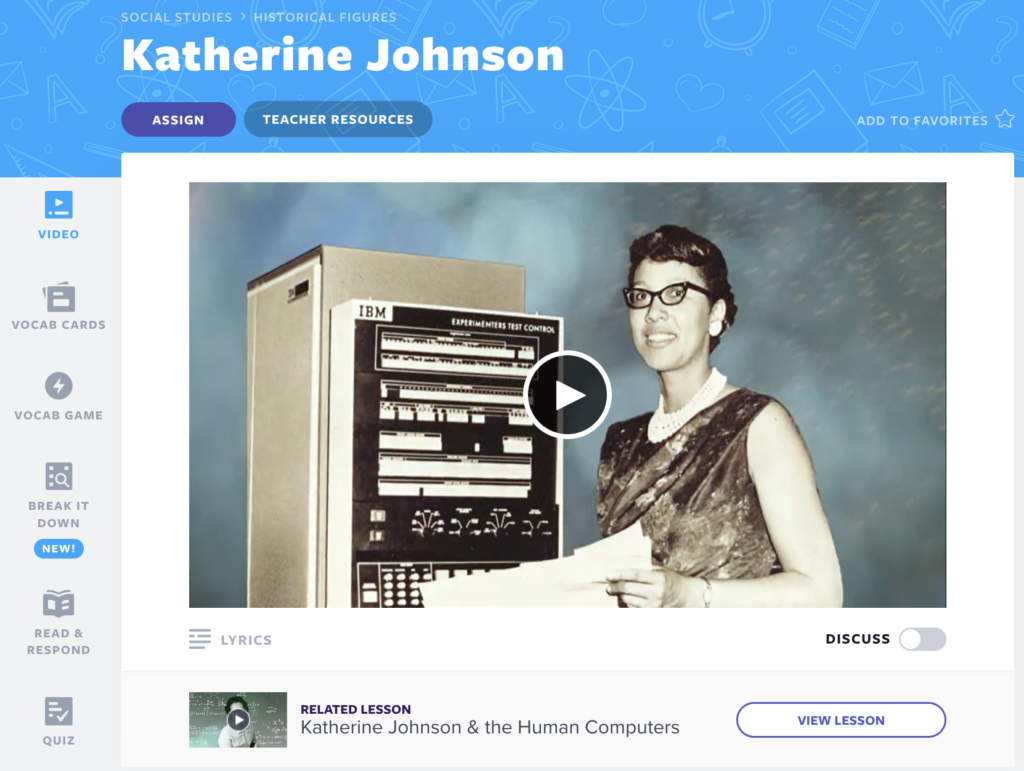
12. Katherine Johnson: Nearpod Original
In this one-minute Nearpod Original video, students learn about Katherine Johnson’s life and legacy. A host explains her incredible accomplishments in the fields of science and tech, and students consider her contributions to racial and social justice movements.
13. Susan B. Anthony
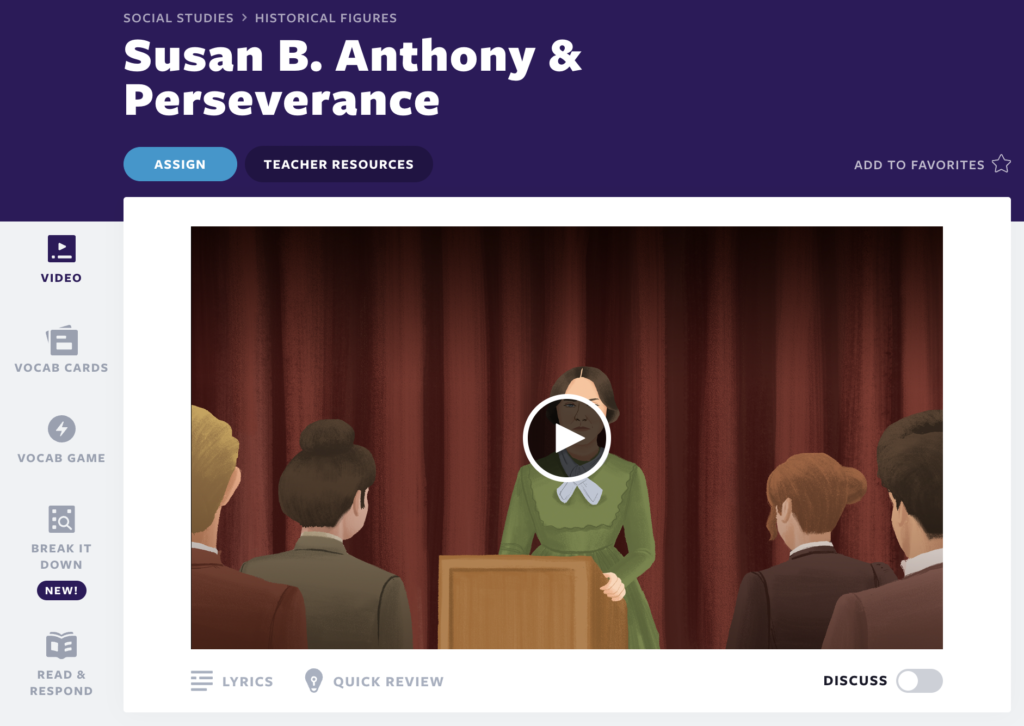
In Susan B. Anthony’s lifetime, women didn’t have the right to vote. So, she made it her life’s work to change that. This lesson showcases how Anthony’s perseverance, loyal friends, and dedication to her cause were pivotal in the long fight for women’s suffrage, culminating in her historic trial before the Supreme Court. Use this video along with Women’s History Month activities for elementary and middle school to inspire students with her enduring legacy.
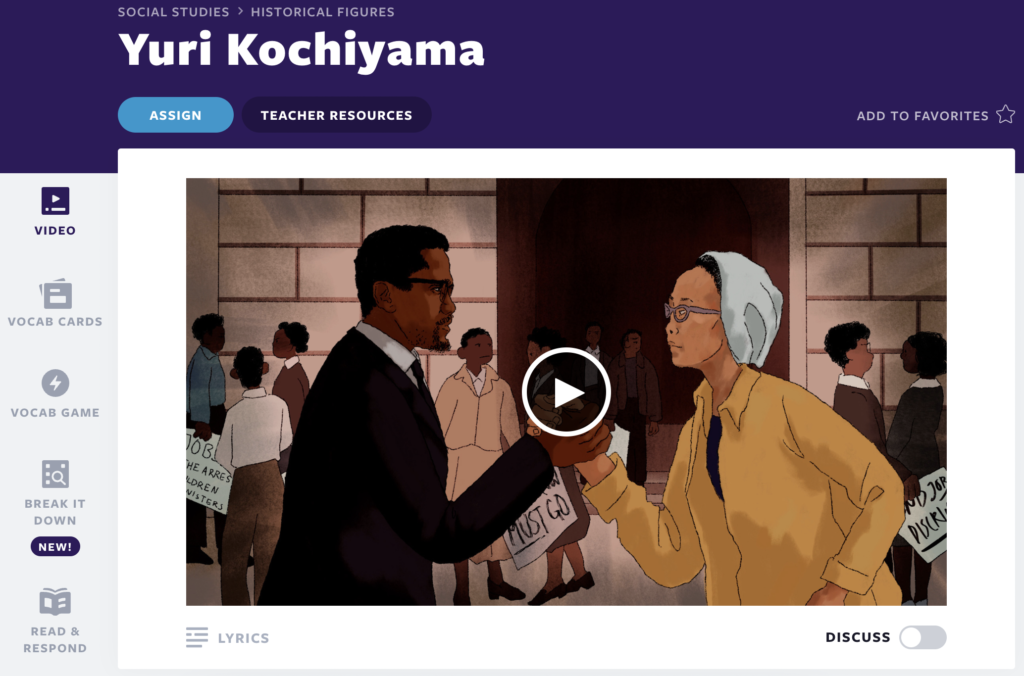
14. Yuri Kochiyama
“We are all part of one another.” Yuri Kochiyama was a Japanese American activist who pushed for equal rights for all Americans. In this lesson, students will learn about Kochiyama’s experience in an internment camp during World War II, her friendship with Malcolm X, and her contributions to various political causes throughout her life.
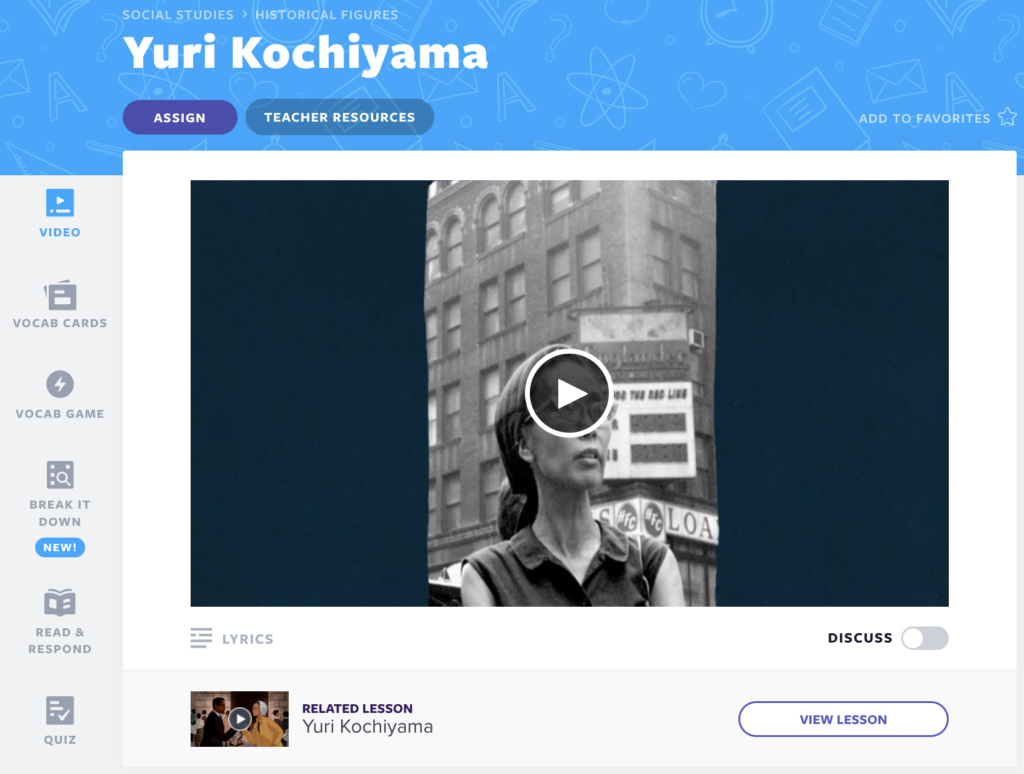
15. Yuri Kochiyama: Nearpod Original
Who was Yuri Kochiyama? In this Nearpod Original video, students learn about this Asian American civil rights activist. A host explains how Kochiyama’s life experiences influenced her activism, and students consider what activism means to them.
16. Sacagawea
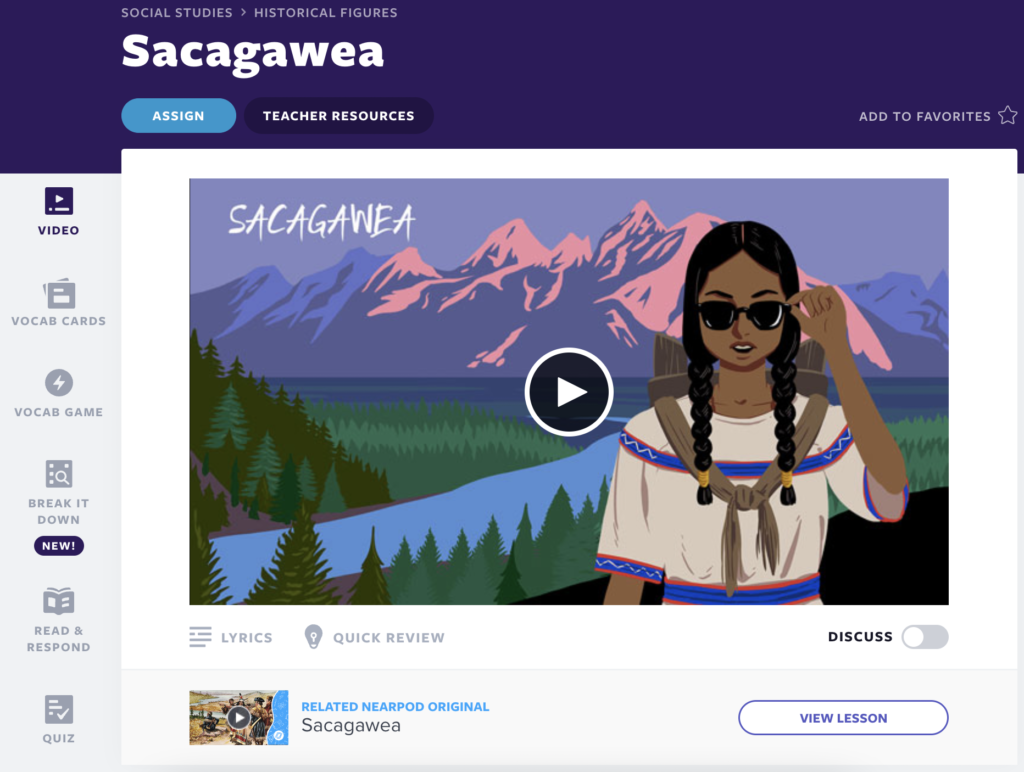
In 1804, Meriwether Lewis and William Clark set off to explore the unknown land of the American Northwest. Their incredible journey took them over the Rocky Mountains to the Pacific Ocean. Still, none of it would have been possible without the help of Sacagawea, a Native American teenager with a new baby. This video will show students how Sacagawea led the Corps of Discovery through uncharted territory and helped begin America’s age of westward expansion.
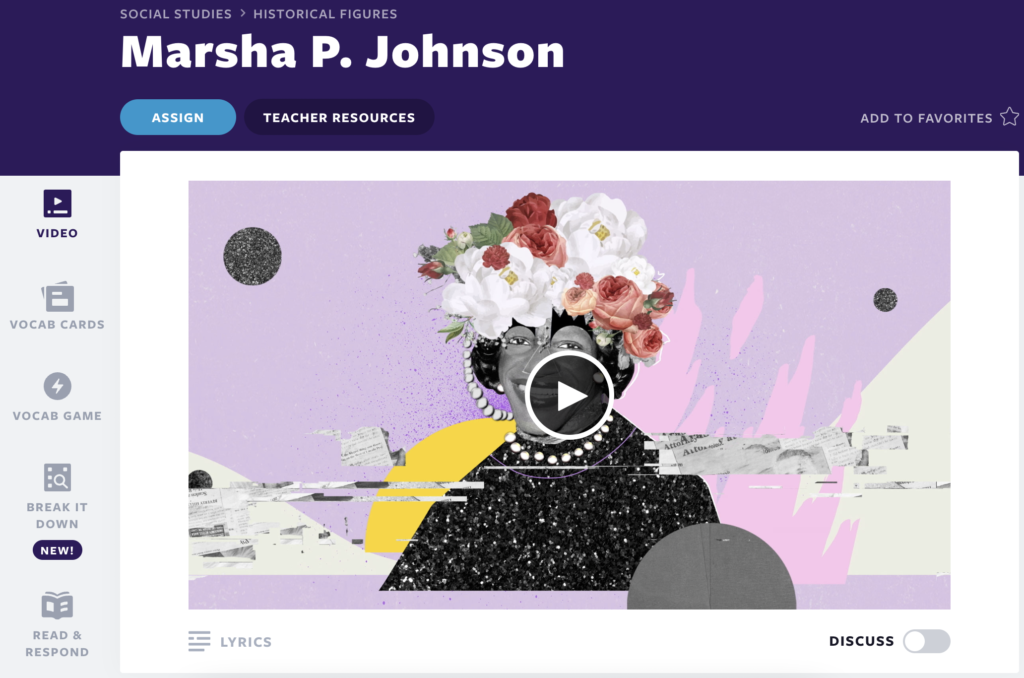
17. Marsha P. Johnson
This lesson introduces students to the life and activism of gay and trans rights activist Marsha P. Johnson. They learn about her childhood, her life in New York City, and her involvement in the gay rights movement of the 1960s and ’70s. They explore her legacy and the lack of recognition she received while still alive.
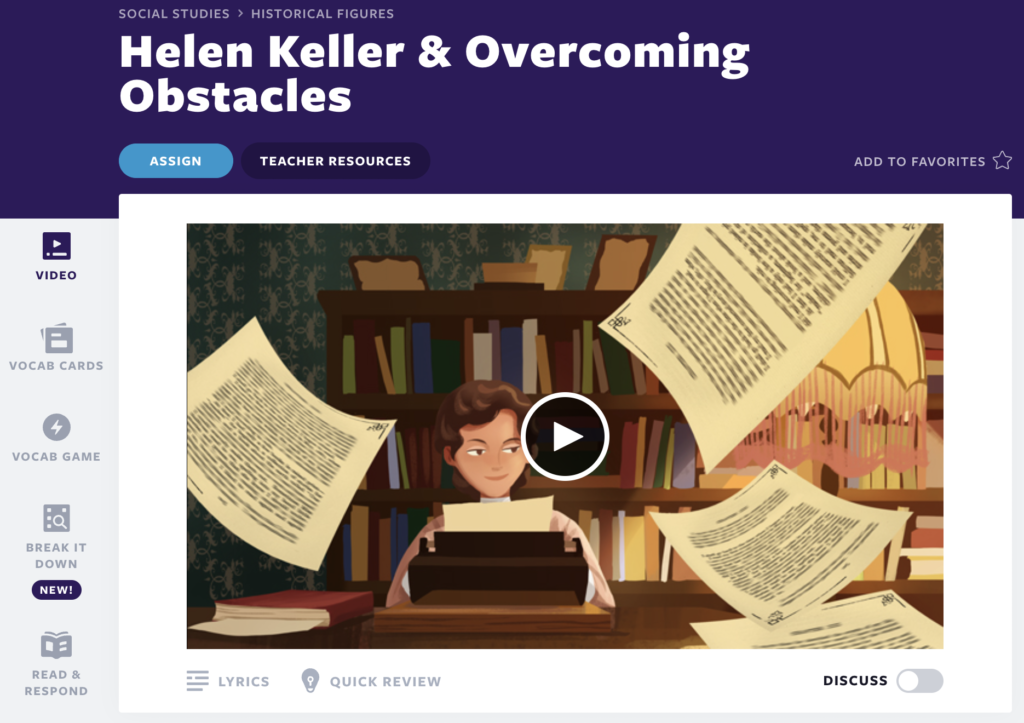
18. Helen Keller
Helen Keller was blind and deaf but learned to communicate with the help of her teacher Anne Sullivan. In this biographical video, you’ll learn how Keller overcame enormous obstacles and then went on to graduate from college. She became an author and an activist who worked for the rights of people with disabilities. You’ll see how she demonstrated great determination and curiosity.
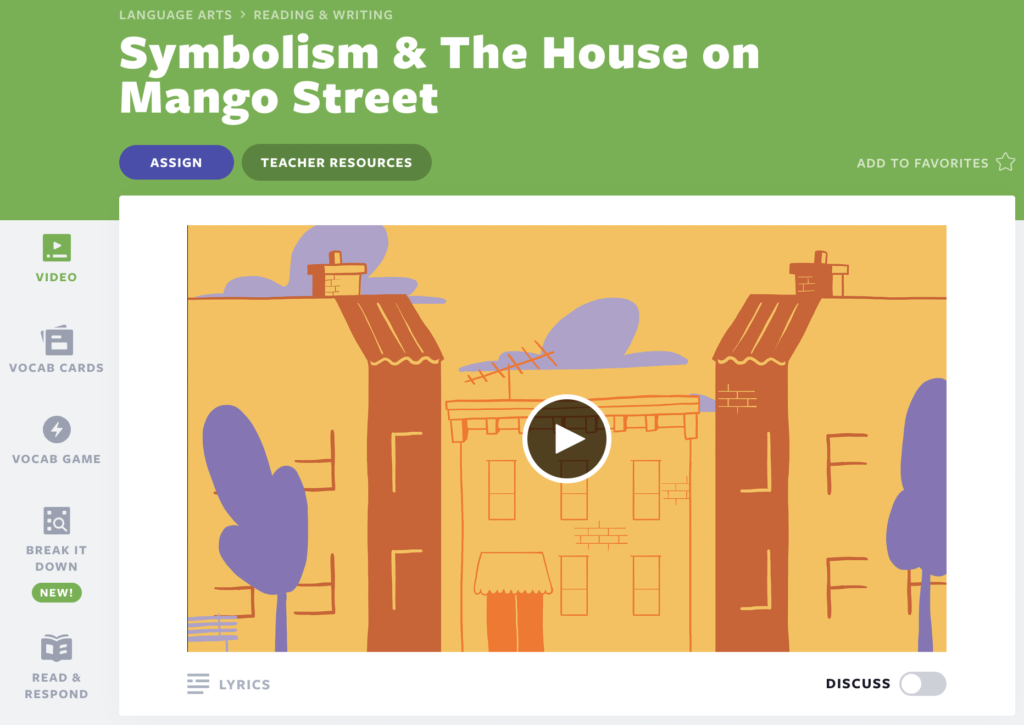
19. Sandra Cisneros
Be a detective as you read—you might find some important symbols beneath the surface. In this lesson, students will be introduced to symbolism and how authors use it. Using a portion of The House on Mango Street by Sandra Cisneros, this lesson teaches students how to identify and interpret symbols and connect them to the overarching themes of a piece of writing.
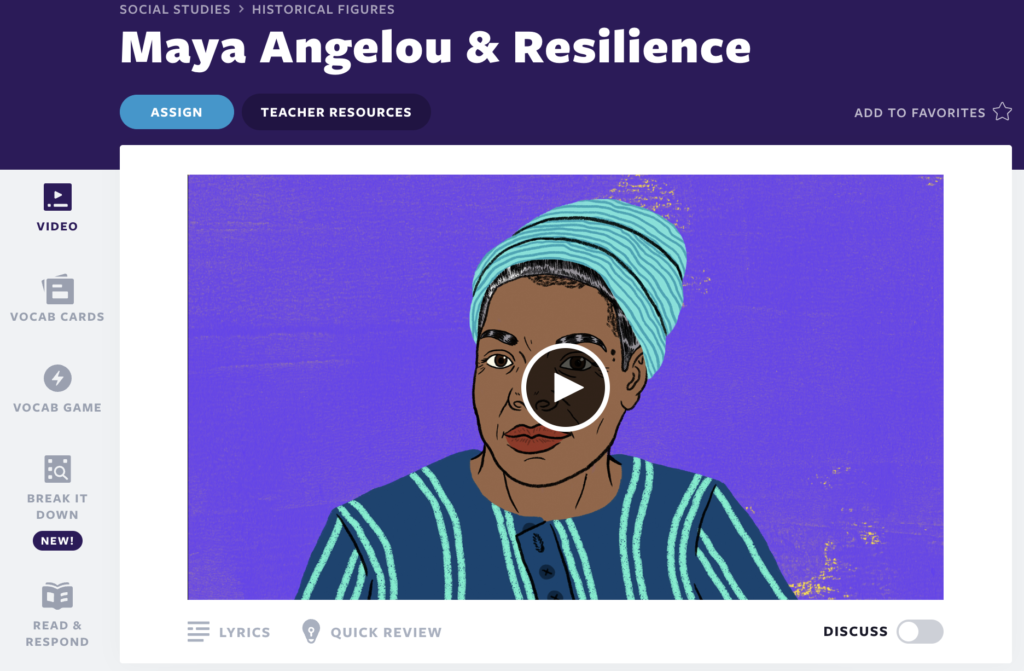
20. Maya Angelou
This lesson introduces students to Maya Angelou, describing her extraordinary life and the significance of her work. Students will analyze Angelou’s trademark use of figurative language and vivid imagery in her poems and memoirs. Include these Women’s History Month videos for students in your lesson plans.
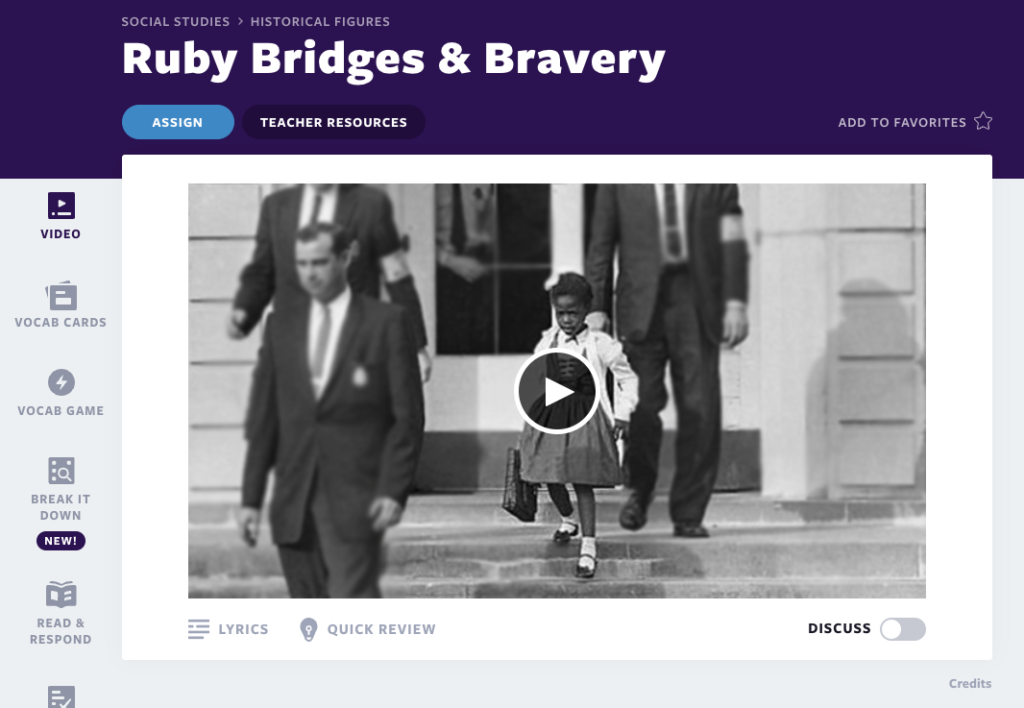
21. Ruby Bridges
In 1960, six-year-old Ruby Bridges changed history by becoming the first black child to desegregate an all-white elementary school by herself. This biographical video tells the story of how Ruby overcame many obstacles to integrate into William Frantz Elementary School, showing great courage in the face of discrimination.
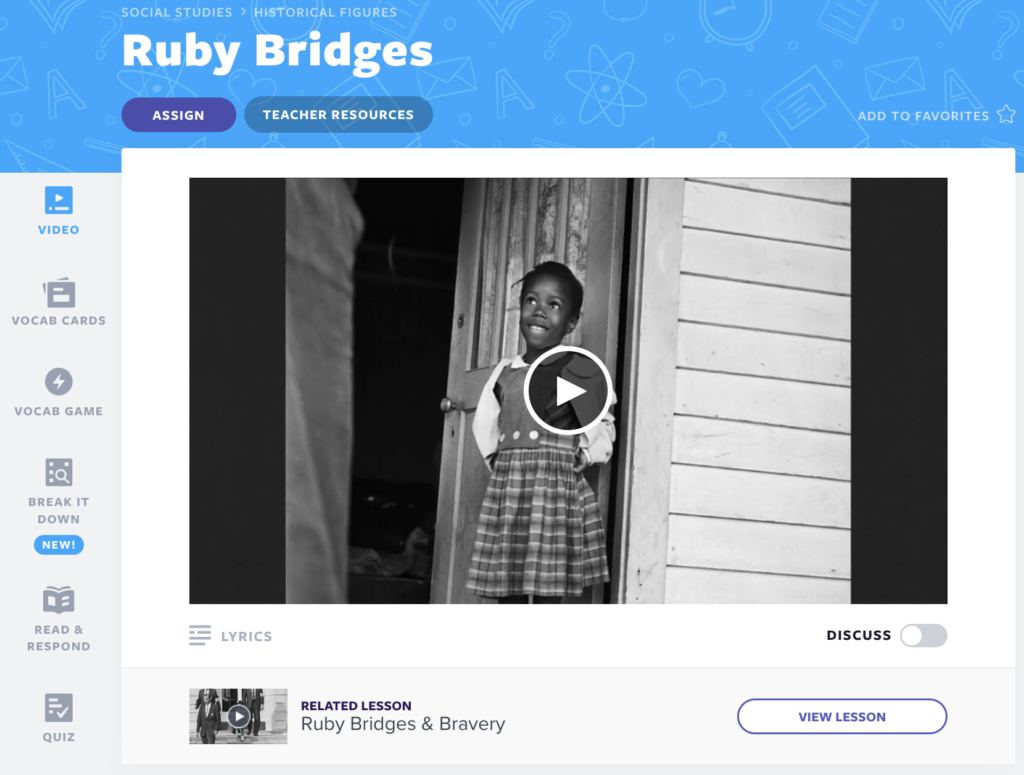
22. Ruby Bridges: Nearpod Original
Can a six-year-old become a civil rights hero? In this one-minute Nearpod Original video, students learn about Ruby Bridges. They explore the context surrounding her entry into an all-White school, and consider how she must have felt walking in on her first day.
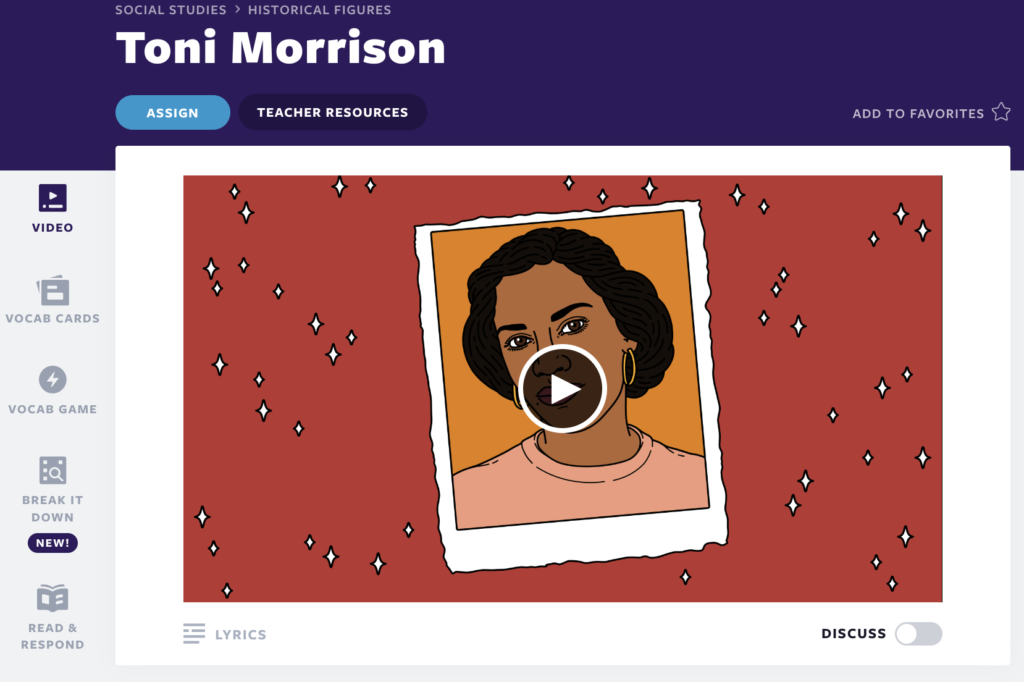
23. Toni Morrison
This lesson introduces students to the life and work of acclaimed American author Toni Morrison. They learn about her childhood in Ohio and career as the first Black female fiction editor at Random House. They explore the social context and universal themes that made Morrison’s work so powerful while learning about Women’s History Month figures.
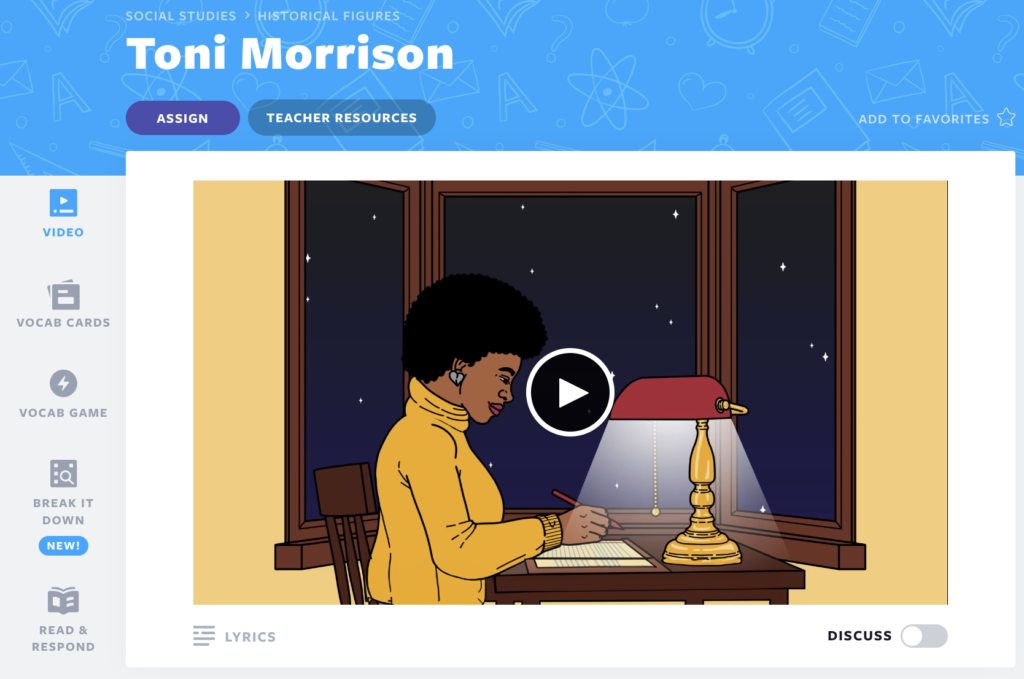
24. Toni Morrison: Nearpod Original
In this one-minute Nearpod Original video, students learn about acclaimed American author Toni Morrison. A host describes Morrison’s life and work, and students explore the social context and universal themes that made her work so powerful.
Start teaching about famous women in history with these video lessons
We’re excited to see you use these video lessons in your classroom! Whether you’re celebrating Women’s History Month or simply incorporating women’s history in your lesson plans, Flocabulary resources are here to support you. Happy Women’s History Month!
New to Flocabulary? Teachers can sign up for a trial to access our lesson videos and assessment activities. Administrators can get in touch with us to learn more about unlocking the full power of Flocabulary through Flocabulary Plus.
